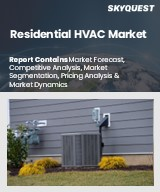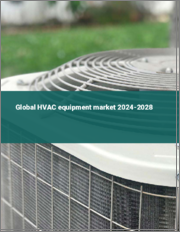
|
시장보고서
상품코드
1479969
세계 HVAC 장비 산업의 성장 기회Global HVAC Equipment Growth Opportunities |
||||||
HVAC의 지속가능성을 촉진하는 재료 및 설계 전략의 보급을 위한 경쟁 심화
Frost & Sullivan은 2023년 세계 HVAC 장비 시장 규모를 2,298억 5,000만 달러로 추정하고 예측 기간 동안 연평균 7% 성장할 것으로 예상하고 있습니다. HVAC 업계는 팬데믹 이후 에너지 효율, 지속가능성, 진화하는 고객 요구사항에 초점을 맞추는 변화의 시기를 맞이하고 있습니다.
실시간 모니터링, 데이터 기반 최적화 및 원격 제어 기능을 갖춘 HVAC 시스템은 효율성 향상, 에너지 사용량 감소 및 사용자 경험 향상으로 인해 널리 선호되고 있습니다. 이러한 파괴적 기술은 HVAC 산업의 성장과 순환 경제로의 전환에 큰 기회를 가져다 줄 것이며, 현재와 미래의 애플리케이션에 높은 성장 잠재력을 제공할 것으로 예상됩니다.
순환 경제가 HVAC 분야에서 큰 지지를 얻으면서 기업들은 제품 수명 연장, 재제조 방법 채택, 재활용 재료의 제품 활용에 점점 더 많은 노력을 기울이고 있습니다.
아시아태평양이 가장 큰 수익 지역이며, 북미와 유럽이 그 뒤를 잇고 있습니다. 이들 핫스팟은 특히 주거 및 상업 부문에서 건설 활동이 지속적으로 성장하고 있습니다. 에너지 소비와 탄소 발자국을 줄이기 위한 엄격한 규제는 북미와 유럽에서 첨단 HVAC 기술의 채택을 더욱 촉진하고 있습니다.
냉방 부문은 전 세계 HVAC 장비 산업의 56.1%를 차지합니다. 사용자 범주 중 상업용 및 주거용 부문이 전체 산업의 89.1%를 차지하며, 2023년에는 상업용이 주거용을 추월하여 더 높은 수익원이 될 것입니다.
목차
전략적 원칙
- 왜 성장이 어려워지는가?
- The Strategic Imperative 8(TM)
- 세계의 HVAC 장비 업계에 대한 주요 전략적 원칙의 영향
- Growth Pipeline Engine(TM)을 촉진하는 성장 기회
성장 기회 분석
- 분석 범위
- 세계의 HVAC 장비, 업종별 세분화
- HVAC 장비 업계의 주요 경쟁사
- HVAC 장비 업계의 주요 성장 지표
- HVAC 장비 업계 유통 채널
- 성장 촉진요인
- 성장 억제요인
- 예측 가정
- 매출 예측
- 매출 예측 분석
- 매출 예측, 지역별
- 매출 예측 분석, 지역별
- 매출 예측, 업종별
- 매출 예측 분석, 업종별
- 매출 예측, 장비 유형별
- 매출 예측 분석, 장비 유형별
- 경쟁 환경
- 시장 점유율
- 경쟁사 상위 5개사
- 시장 점유율 분석
- HVAC 업계의 M&A
- HVAC 업계의 순환 경제에 의한 가치 창조
- HVAC 업계의 순환 이니셔티브
성장 기회 분석 : 북미
- 주요 성장 지표
- 매출 예측
- 매출 예측 분석
- 매출 예측, 장비 유형별
- 매출 예측, 업종별
- 매출 예측 분석, 장비 유형별·업종별
성장 기회 분석 : 유럽
- 주요 성장 지표
- 매출 예측
- 매출 예측 분석
- 매출 예측, 장비 유형별
- 매출 예측, 업종별
- 매출 예측 분석
성장 기회 분석 : 아시아태평양
- 주요 성장 지표
- 매출 예측
- 매출 예측 분석
- 매출 예측, 장비 유형별
- 매출 예측, 업종별
- 매출 예측 분석
성장 기회 분석 : 중동 및 아프리카(MEA)
- 주요 성장 지표
- 매출 예측
- 매출 예측 분석
- 매출 예측, 장비 유형별
- 매출 예측, 업종별
- 매출 예측 분석
성장 기회 분석 : 라틴아메리카
- 주요 성장 지표
- 매출 예측
- 매출 예측 분석
- 매출 예측, 장비 유형별
- 매출 예측, 업종별
- 매출 예측 분석
성장 기회 유니버스
- 성장 기회 1 : HVAC 업계 순환을 촉진하는 IoT
- 성장 기회 2 : 빌딩 탈탄소화를 추진하는 그린 HVAC
- 성장 기회 3 : 원재료 부족에 대처하는 분해 설계
부록
다음 스텝
ksm 24.05.31Competitive Intensity to Propagate Material and Design Strategies Promoting HVAC Sustainability
Frost & Sullivan estimates the global HVAC equipment industry at $229.85 billion in 2023 and is projected to grow at a 7% CAGR in the forecast period. The HVAC industry is undergoing a transformation that emphasizes energy efficiency, sustainability, and evolving customer demands in a post-pandemic world.
HVAC systems offering real-time monitoring, data-driven optimization, and remote-control capabilities, leading to improved efficiency, reduced energy usage, and enhanced user experiences, are widely preferred. Such disruptive technologies will offer high growth potential for present and future applications with significant opportunities for HVAC industry growth and transformation toward a circular economy.
As circularity gains significant traction in the HVAC sector, companies are increasingly focused on extending product life spans, adopting remanufacturing practices, and utilizing recycled materials in their products.
Asia-Pacific is the largest revenue-generating region, followed by North America and Europe. These hotspots see sustained growth in construction activity, particularly in the residential and commercial segments. Stringent regulations to reduce energy consumption and carbon footprints further drive the adoption of advanced HVAC technologies in North America and Europe.
The cooling segment accounted for 56.1% of the global HVAC equipment industry. Among the user categories, commercial and residential segments accounted for 89.1% of the total industry, with commercial usage edging past residential as the higher revenue generator in 2023.
Table of Contents
Strategic Imperatives
- Why is it Increasingly Difficult to Grow?
- The Strategic Imperative 8™
- The Impact of the Top 3 Strategic Imperatives on the Global Heating Ventilation and Air Conditioning Equipment Industry
- Growth Opportunities Fuel the Growth Pipeline Engine™
Growth Opportunity Analysis
- Scope of Analysis
- Global HVAC Equipment Vertical Industry Segmentation
- Key Competitors in the HVAC Equipment Industry
- Key Growth Metrics in the HVAC Equipment Industry
- HVAC Equipment Industry Distribution Channels
- Growth Drivers
- Growth Restraints
- Forecast Assumptions
- Revenue Forecast
- Revenue Forecast Analysis
- Revenue Forecast by Region
- Revenue Forecast Analysis by Region
- Revenue Forecast by Vertical
- Revenue Forecast Analysis by Vertical Industry
- Revenue Forecast by Equipment Type
- Revenue Forecast Analysis by Equipment Type
- Competitive Environment
- Market Share
- Top 5 Competitors
- Market Share Analysis
- Mergers and Acquisitions in the HVAC Industry
- Value Creation through Circular Economy in the HVAC Industry
- Circular Initiatives in the HVAC Industry
Growth Opportunity Analysis: North America
- Key Growth Metrics
- Revenue Forecast
- Revenue Forecast Analysis
- Revenue Forecast by Equipment Type
- Revenue Forecast by Vertical Industry
- Revenue Forecast Analysis by Equipment Type and Vertical Industry
Growth Opportunity Analysis: Europe
- Key Growth Metrics
- Revenue Forecast
- Revenue Forecast Analysis
- Revenue Forecast by Equipment Type
- Revenue Forecast by Vertical Industry
- Revenue Forecast Analysis
Growth Opportunity Analysis: Asia-Pacific
- Key Growth Metrics
- Revenue Forecast
- Revenue Forecast Analysis
- Revenue Forecast by Equipment Type
- Revenue Forecast by Vertical Industry
- Revenue Forecast Analysis
Growth Opportunity Analysis: Middle East and Africa (MEA)
- Key Growth Metrics
- Revenue Forecast
- Revenue Forecast Analysis
- Revenue Forecast by Equipment Type
- Revenue Forecast by Vertical Industry
- Revenue Forecast Analysis
Growth Opportunity Analysis: Latin America
- Key Growth Metrics
- Revenue Forecast
- Revenue Forecast Analysis
- Revenue Forecast by Equipment Type
- Revenue Forecast by Vertical Industry
- Revenue Forecast Analysis
Growth Opportunity Universe
- Growth Opportunity 1: IoT to Promote Circularity in the HVAC Industry
- Growth Opportunity 2: Green HVAC to Drive Decarbonization in Buildings
- Growth Opportunity 3: Design for Disassembly to Combat Raw Material Shortage
Appendix
- List of Other Companies
- Frost & Sullivan's 6P Framework for Sustainability
Next Steps
- Your Next Steps
- Why Frost, Why Now?
- List of Exhibits
- Legal Disclaimer



















